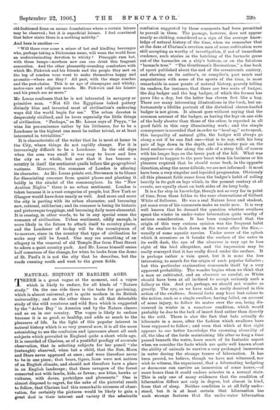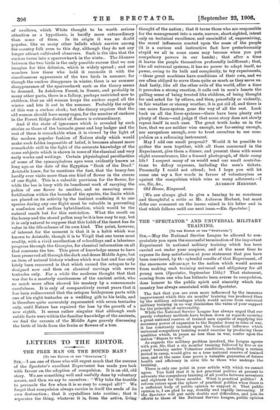NATURAL HI§TORY IN EARLIER AGES.
THERE is a great vogue at the moment, and a vogue which is likely to endure, for all kinds of "Nature study." On the one side there is the taste for gardening, which is almost universal, yet is quite modern in its British universality; and on the other there is all that delectable study of the wild creatures and wild flora which is suggested by the "Arbor Day" in America and by the Nature classes and so on in our country. The vogue is likely to endure because it is so good, so healthy, and adds so much to the pleasures of life. In the light of this popular interest in natural history which is so very general now, it is all the more astonishing to see the confusion and ignorance about all such subjects which prevailed in England quite a short while ago. It is recorded of Clarissa, as of a youthful prodigy of accurate observation, that in selecting subjects for her pencil "she (untaught) observed, when but a child, that the Sun, Moon and Stars never appeared at once; and were therefore never to be in one piece; that bears, tigers, lions were not natives of an English climate, and should not therefore have a place in an English landscape; that these ravagers of the forest consorted not with lambs, kids, or fawns; nor kites, hawks or vultures, with doves, partridges and pheasants." One is almost disposed to regret, for the sake of the pictorial result to follow, that Clarissa had this remarkable niceness of obser- vation, for certainly the pictures would be likely to gain a great deal in their interest and variety if the admirable confusion suggested by these comments, had been permitted to prevail in them. The passage, however, does not appear nearly so striking, considered as a sign of the average know- ledge of natural history of the time, when we remember that at the date of Clarissa's creation men of some cultivation were still accepting as worthy of investigation, if not of immediate credence, such 'stories as the hatching of the barnacle geese out of the barnacles on a ship's bottom, or on the fabulous "barnacle tree." "The Gentleman's Recreations," a fine book of sport published about the end of the seventeenth century, and showing on its author's, or compiler's, part much real acquaintance with some of the sports of the time, is most remarkable in some points of natural history, gravely telling its readers, for instance, that there are two sorts of badger, the dog badger and the bog badger, of which the former has paws like a dog, but the latter has cloven feet like a hog. There are many interesting illustrations in the book, but un- fortunately a lifelike portrait of the diabolical cloven-hoofed badger is not given. It almost goes without saying that the common account of the badger, as having the legs on one side of the body shorter than those of the other, is repeated in all good faith in this very illuminating work ; and the simple consequence is recorded that in order to "level up," so to speak, this inequality of natural gifts, the badger will always go along a rut if he can find one—that is to say, with his long pair of legs down in the depth, and his shorter pair on the level surface—or else along the side of a steep bill, of course with his longer legs on the lower part of the bill. What was supposed to happen to the poor beast when his business or his pleasure required that he should come back, in the opposite direction, along the same hillside, we are not informed : it must have been a very singular and lopsided progression. Obviously all this pleasant fable came from the badger's habit of rolling heavily in its gait on legs which, in the present century at all events, are equally short on both sides of its long body.
It is a far step in knowledge, though not so very far in point of time, from these fables to the sane observations of Gilbert White of Selborne. He was a real Nature lover and student, yet some even of his comments make Us smile now. It is very well known that he deemed the question whether swallows spent the winter in under-water hibernation quite worthy of serious consideration. It has been conjectured that the origin of this very curious opinion was the frequent habit of the swallow to dash down on the water after the flies,— usually of some aquatic species. Under cover of the splash which it occasions as it breaks the surface of the water in its swift dash, the eye of the observer is very apt to lose sight of the bird altogether, and the impression may be easily conveyed that it has really dived under the surface. It is perhaps rather a vain quest, but it is none the less interesting, to search for the origin of such popular fallacies ; but this particular explanation commends itself by a very apparent probability. The wonder begins when we think that a man so cultivated, and an observer so careful, as White should have been at all inclined to accept seriously such a fallacy as this. And yet, perhaps, we should not wonder so greatly. The eye, as we have said, is easily deceived in this action of the swallows. Several facts may have lent colour to the notion, such as a single swallow, having failed, on account of some injury, to follow its mates over the sea, being dis- covered in winter in a comatose condition, which would probably be due to the lack of insect food rather than directly to the cold. There is also the fact that bats actually do hibernate, in a mass, after the fashion which swallows have been supposed to follow ; and even that which at first sight appears to our better knowledge the crowning absurdity of all, the idea of the birds maintaining life after so long a time passed beneath the water, loses much of its fantastic aspect when we consider the facts which are quite well known about the ability of animals to survive a very prolonged immersion in water during the strange trance of hibernation. It has been proved, we believe, though we have not witnessed, nor wish to witness, the experiment, that a hibernating hedgehog or dormouse can survive an immersion of some hours,--of more hours than it could endure minutes in a normal 'state. This is only one of many evidences that the condition of hibernation differs not only in degree, but almost in kind, from that of sleep. Neither condition is at all fully under- stood, but it is at least certain that hibernation has such strange features that the under-water hibernation
of swallows, which White thought to be worth serious attention as a hypothesis, is hardly more extraordinary than Some of them. In its origin it was no doubt popular, like so many other beliefs which survive among the country folk even to this day, although they do not any longer attract cultivated observers. Such is the idea that the cuckoo turns into a sparrowhawk in the *into,. The likeness between the two birds is the only possible excuse that we can imagine for this delusion, which is widely spread ; and one wonders how those who hold it reconcile it with the simultaneous appearance of the two birds in summer, for though the cuckoo disappears in winter, there is no summer disappearance of the sparrowhawk such as the theory seems to demand. In Ashdown Forest, in Sussex, and probably in many other parts, there is a fallacy, perhaps restricted now to children, that an old woman keeps the cuckoo caged all the winter and lets it out in the summer. Probably the origin of this was a cuckoo clock ; but the theory requires that the old woman should have many cages, for the number of cuckoos in the Forest Ridge district of ,Sussex is extraordinary.
And if the state of ignorance which is revealed by such stories as those of the barnacle geese and hog badger and the rest of them is remarkable when it is viewed by the light of the modern popular fashion of Nature study which would make such fables impossible of belief, it becomes almost more remarkable still in the light of the accurate knowledge of the same subjects which is shown in some of the classical and very early works and writings. Certain physiological peculiarities of some of the cynocepbalous apes were evidently known as long ago as the date of the Egyptian "Book of the Dead." Aristotle knew, for be mentions the fact, that the honey-bee hardly ever visits more than one kind of flower in the course of one flight. This is a valuable provision for the flower, for while the bee is busy with its beneficent work of carrying the pollen of one flower to another, and so ensuring cross- fertilisation within the bounds of the species, the limits which are placed on its activity by the instinct confining it to one species during any one flight must be valuable in preventing a confusion and endless hybridisation, which would be the natural result but for this restriction. What the result on the honey and the stored pollen may be it is less easy to say, but it is only natural to suppose that this habit of the insect has its value in the life-scheme of its own kind. The point, however, of interest for the moment is that it is a habit which was known to Aristotle, though it is to -Virgil that one turns most readily, with a vivid recollection of schooldays and a laborious progress through the Georgics, for classical information on all that concerns the bee. This piece of knowledge seems to have been preserved all through the dark and dense Middle Ages; but an item of natural history wisdom which was lost and has only lately been recovered is that which caused the octopus to be designed now and then on classical carvings with seven tentacles only. For a while the moderns thought that that was due to a masterly carelessness of the ancient artist, who so much more often showed his mastery by a consummate carefulness. It is only of comparatively recent years that it has been rediscovered that the octopus bridegroom parts with one of his eight tentacles as a wedding gift to his bride, and is therefore quite accurately represented with seven tentacles only, until Nature has repaired the loss by the growth of a new eighth. It seems rather singular that although such subtle facts were within the familiar knowledge of the ancients, we find the savants of the Middle Ages gravely discussing the birth of birds from the fruits or flowers of a tree.







































 Previous page
Previous page